Rumble Resources maintains a highly-experienced technical team and high-quality exploration portfolio, focused exclusively on the emerging Fraser Range province of Western Australia, within two key project areas.
| Corporate Details | 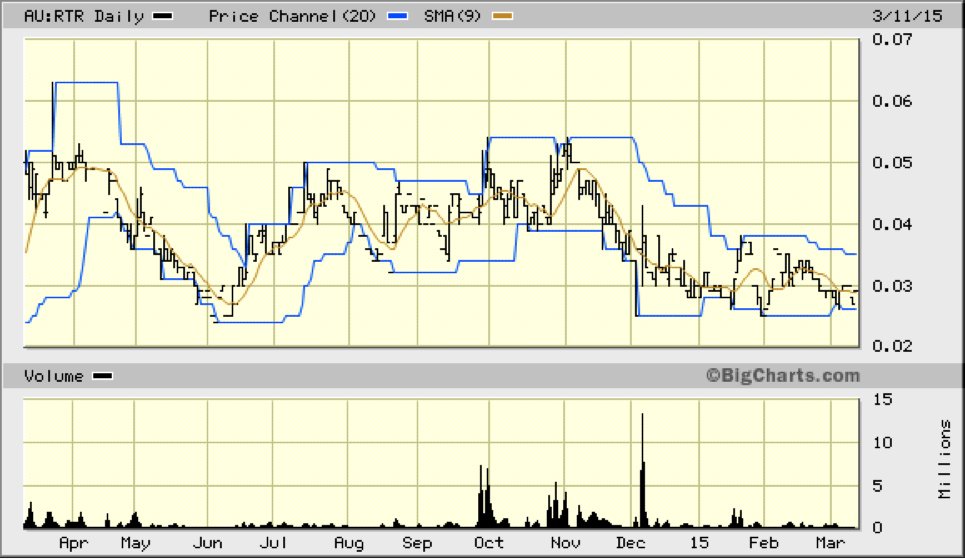 |
| Status: Regional Explorer | |
| Size: Small Cap | |
| Commodity Exposure: Nickel | |
| Share Price: $0.029 | |
| 12-month Range: $0.025 – $0.063 | |
| Shares: 150m, Options: 83m | |
| Top 20: 74% | |
| Net Cash: $1.2m | |
| Market Value: $4m |
| Key Parameters | Rating (✓out of 5) | Quarterly Statistics |
| Management Quality | ✓✓✓✓✓ | Q4 2014 Exploration Spend: $0.308m |
| Financial Security | ✓✓✓✓ | Q4 2014 Administration Spend: $0.388m |
| Project Quality | ✓✓✓✓✓ | Exploration Spend 44%, Admin. Spend 56% |
| Exploration / Resource Potential | ✓✓✓✓✓ | Q1 2015 Forecast Exploration Spend: $0.35m |
| Project Risk | ✓✓✓✓✓ | Q1 2015 Forecast Exploration Spend: $0.35m |
We introduced Rumble Resources to our Portfolio during December 2014 following an impressive initial briefing by company management here in Sydney. The company complements our existing range of high-quality Fraser Range Portfolio exploration exposures, including Matsa Resources and Sheffield Resources. Rumble maintains a high-calibre exploration team and highly prospective exploration tenements within Western Australia’s Fraser Range nickel province, not far from Sirius Resources’ Nova discovery.
The emerging Fraser Range nickel province has generated significant excitement and strong activity since Sirius Resources’ Nova discovery during mid-2012, and has the potential to become a world-class nickel province. Nova-Bollinger is the first of a specific type of deposit found in Australia, and from the Canadian experience (Voiseys Bay, Thompson, Raglan) these magmatic nickel-copper-PGE deposits occur in camps, with belts containing multiple deposits. Rumble maintains two major projects – Big Red and Zanthus.
Work by Rumble has so far included analysis of public data, which has defined a number of prospective targets that the company is in the process of evaluating through drilling. A number of the targets at Zanthus demonstrate geological and geophysical similarities to those associated with Sirius’ Nova deposit (primarily similar EM and magnetic signatures). Meanwhile at the Big Red project, exploration work has delineated a possible “feeder-style” target that’s potentially analogous to the “Ovoid” mineralisation at Voiseys Bay.
Zanthus Project
The company’s Zanthus Project is situated 20km east of Sirius Resources’ (ASX: SIR) Nova-Bollinger nickel-copper massive sulphide discoveries, within the Fraser Range province. Rumble is earning up to a 75% stake in the project from Blackham Resources (ASX: BLK).
Earlier this month Rumble advised that it’s much-anticipated maiden RC drilling program at Zanthus was set to commence during late March. The program will comprise five RC holes for 1,200 metres targeting five bedrock conductors that could represent magmatic massive nickel sulphides.
The Zc1, 2 & 3 conductors are of significant conductance and represent first-order drill targets, situated in and around an “eye” intrusive feature. The feature is interpreted as an elliptical magnetic-rimmed intrusive body some 2km in length and up to 1km wide – and of similar size to the Nova “eye” feature.
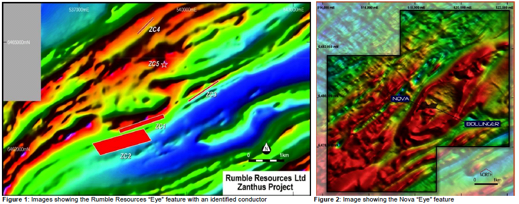
Separately, a high-powered ground EM survey has commenced on conductor ZC5, located within the eye feature, to better define a deep, conductive body. The survey is expected to take one week to complete, with geophysical interpretation to follow.
Technical Significance
Recent developments have highlighted the prospectively of the Fraser Range region to host another major nickel discovery. Sirius Resources recently advised that initial drilling at its Crux prospect had intersected nickel sulphides. The Crux anomaly is a thick (>500-metre), 6km long “eye- like” intrusion and initial drilling has intersected Nova-style host rock, with a broad zone of trace sulphides and localised disseminated and matrix sulphides, with visible pentlandite (nickel) and chalcopyrite (copper).
Separately, Mount Ridley Mines (ASX: MRD) recently has reported that first-pass air-core drilling at its Mt Ridley project had intersected mafic-ultramafic intrusive rocks, containing primary nickel and copper mineralisation. The drilling has confirmed the presence of primary magmatic sulphides of nickel and copper, targeting ovoid-shaped magnetic features that are similar to the Nova “eye” feature.
Both Sirius and Mount Ridley are targeting large “eye” intrusive bodies, which are indicators commonly associated with mafic intrusive complexes that host Ni-Cu-PGE ore bodies – and are therefore priority targets when looking for orebodies that can contain zones of massive sulphides. The world-class Nova massive sulphide nickel copper discovery was found through drilling a bedrock conductor within an “eye” intrusive.
Project Background
The Zanthus project hosts a significant structural corridor with numerous large intrusive features and significant magnetic highs that host several ovoid-shaped magnetic anomalies that are similar to that hosting the Nova deposit. This zone represents a significant structural break within the regional geology and covers a large area measuring approximately 14km by 5km, and will be a major focus area of next-stage exploration, which is part of a systematic exploration approach to the Fraser Range Project areas.
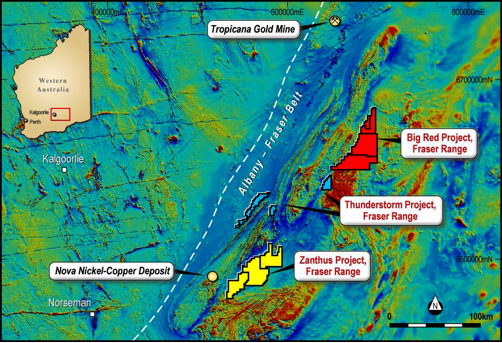
Rumble has also been successful with its application for the Western Australian State Government’s Exploration Incentive Scheme (EIS) at Zanthus, having been awarded up to $150,000 in co-funding to drill-test the Zanthus bedrock conductors. The grant will enable Rumble to utilise its cash reserves to fund further exploration on other Fraser Range exploration programs. The EIS is a competitive process with the company now receiving grants for both the Big Red and Zanthus projects, highlighting the prospectivity of Rumble’s Fraser Range projects.
Big Red Project
Rumble recently received all assay results from its recently-completed maiden drilling program on its Big Red project, situated 450km east of Kalgoorlie in Western Australia. The assays have confirmed that all three initial holes have intersected large, disseminated mineralised sulphide zones within gabbros of the Fraser Range Complex, with the largest over 40 metres in thickness.
These sulphide zones have been identified over considerable widths and indicate this large conductor to be a significant mineralised system. Intersecting Fraser gabbro is a significant development, as it is the targeted rock unit that can host magmatic Ni-Cu sulphide deposits. The sulphides zones are anomalous in copper, nickel and cobalt.
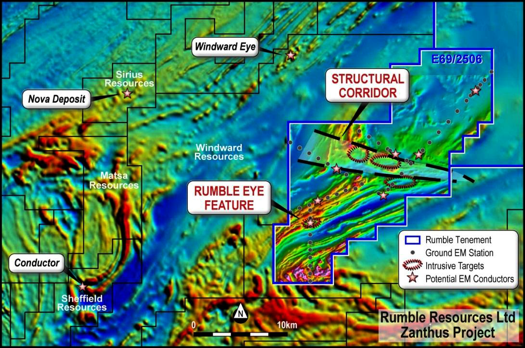
Technical Significance
It is thought that the Big Red gabbro could be part of a layered mafic/ultramafic sequence and further geochemistry is now being undertaken, along with detailed petrographic studies of the sulphide zones.
The Big Red gabbro also shows evidence of hybridisation. The Geological Survey of Western Australia (GSWA) has identified two main types of hybrid gabbros within the Fraser Range. These are formed where the main gabbros have incorporated felsic material through assimilation or magma mixing. They are formed through two distinct processes and are located throughout the Fraser Range.
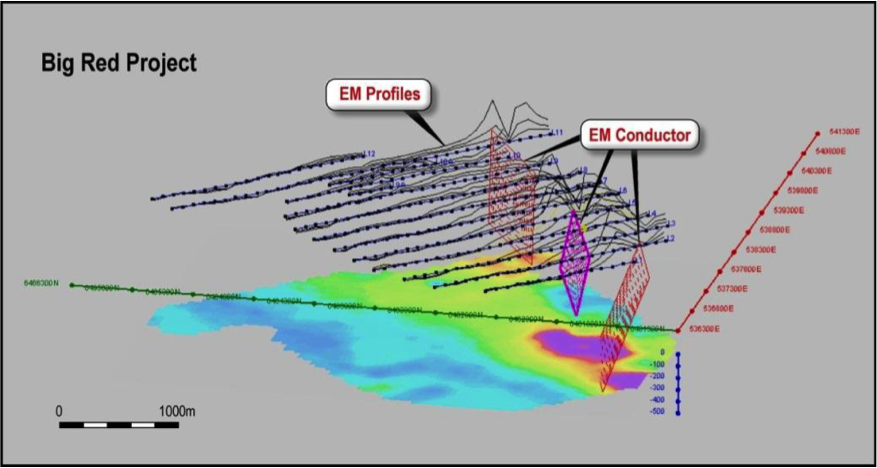
The Big Red gabbro forms part of Hybrid Group 1 that is enriched in thorium and has high Th/La ratios. These gabbro units are thought to have been formed from the incorporation of surrounding felsic material into the main gabbro melt during ascent or emplacement. Rumble is now obtaining more detailed platinum group element and rare earth element geochemistry to further investigate the evolution of the Big Red gabbro to aid in future target generation for magmatic nickel and copper sulphides.
Within close proximity there are significant bedrock conductors that could represent massive sulphide accumulations, which are high-priority targets. Before the next stage of drilling commences, the next phase of technical work will incorporate detailed modelling of the bedrock conductors in order to determine the strike, dip and depth of the bodies, along with detailed petrographic analysis of the magmatic sulphides. Based on the results of this work, the next phase of drilling will be planned following the completion of the Zanthus drilling program.
Project Background
The geology of the Big Red project generally consists of felsic and mafic gneisses of the Fraser Range Complex. Previous drilling by Teck Australia intersected thin gabbro units that were age-dated at around 1.3 billion years old, which is the age of the Fraser Range complex. The maiden drilling by Rumble intersected much broader zones of gabbro and more mafic gneisses, with the two southern holes – BRDD002 and BRDD004 – intersecting large disseminated sulphides zones.
These sulphide zones are of considerable widths and indicate the conductor to be within a large mineralised system. The three drill-holes have only tested a small section of the 2km bedrock conductor (and a total strike length of just 500 metres), highlighting the area’s potential.
Summary
The commencement of drilling at Zanthus complements the encouraging results received from the initial drilling program at the Big Red project, which has delineated a possible “feeder-style” target potentially analogous to the “Ovoid” mineralisation at Voiseys Bay. With a market value of just $4.3m and cash reserves of $2m, the stock is modestly valued but hugely leveraged to exploration success. We therefore maintain our Speculative Buy recommendation around $0.029.







